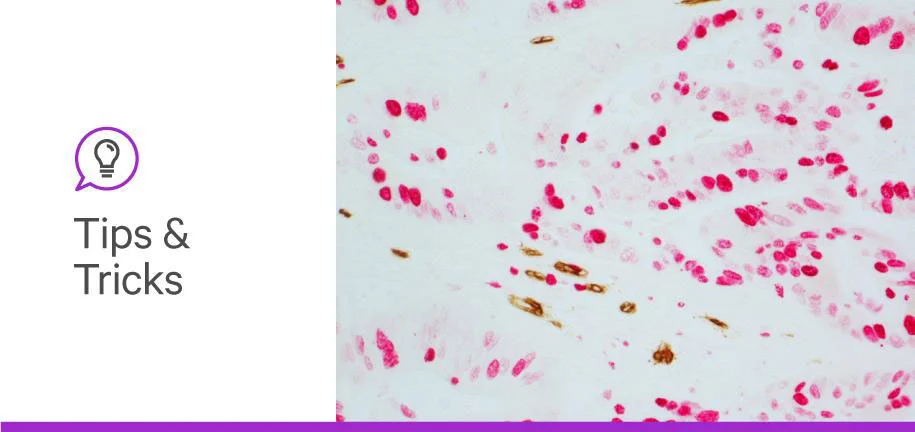
Vector Laboratories is closed for the President’s Day on Monday, February 19th. We will be back in the office on Tuesday, February 20th.
We will respond to emails upon our return. Have a wonderful day.
Menu
Vector Laboratories is closed for the President’s Day on Monday, February 19th. We will be back in the office on Tuesday, February 20th.
We will respond to emails upon our return. Have a wonderful day.

Immunohistochemistry (IHC) relies on specific binding interactions between a biomolecule and an antigen. Typically, this biomolecule is an antibody. An antibody which binds directly to the antigen of interest is called a primary antibody. The primary antibody can be bound to a detectable tag for visualization, but more commonly, a secondary antibody is utilized.
An antibody whose antigen is another antibody is called a secondary antibody (2° Ab). There are many benefits of using a secondary antibody including increased sensitivity and saving money on primary antibody optimization. Many options exist when choosing a secondary antibody, and this blog will discuss the considerations in choosing a secondary antibody for IHC.
Antibodies are produced for laboratory work by utilizing the natural immune systems of animals. In a simplified example, an antigen is introduced into an animal (host species) and that animal’s immune system creates antibodies against the introduced antigen which can then be captured and purified for laboratory use. This means there are a variety of different animal host species to be aware of. When choosing a secondary antibody, it is ideal to choose a host species not closely related to the species of the tissue sample to prevent cross reactivity.
A secondary antibody is raised against a specific target species. The target species must align with the host species of the primary antibody. For example, the primary antibody rabbit anti-CD24 has a rabbit host species and is raised against the antigen CD42. For this example, an appropriate secondary antibody could be a goat anti-rabbit antibody. This has a goat host species raised against rabbit (target species) for the recognition of the primary antibody.
Now that the specific species have been selected, it is time to determine the conjugation of the secondary antibody, or the way in which visual detection is made possible. This will affect the workflow, detection system, and sensitivity.
A secondary antibody can be directly conjugated to a reporter enzyme, which is an enzyme that reacts with a substrate to yield a localized, colored precipitate for visualization. A direct conjugation to a secondary antibody is typically used when the target antigen is prevalent and easily detectable because this is the least sensitive format. One benefit of this format is a simplified workflow.
A format with increased sensitivity is a biotinylated secondary antibody. This is used with an avidin-biotin complex (ABC) detection system. An ABC molecule is a complex of (strept)avidin bound to a reporter enzyme. A biotinylated secondary antibody will have multiple available biotins. This means multiple ABC molecules can bind to the secondary antibody, allowing for an amplified signal and increased sensitivity. This is an appropriate option for antigens with lower expression levels.
Another format of secondary antibodies is an enzyme polymer detection system, which integrates secondary antibodies with a high-density micropolymer array of reporter enzyme. This increases sensitivity by introducing more enzymes at the site of the primary antibody. It also simplifies the detection into fewer incubation steps.
Directly conjugated secondary antibodies and enzyme polymer systems both have a reporter enzyme in some format conjugated to the secondary antibody. This means in the secondary antibody selection it is necessary to determine which enzyme to use. Alkaline phosphatase (AP) and horseradish peroxidase (HRP) are the two most used enzymes. The enzyme must match the substrate chosen for downstream visualization.
Sometimes it is unavoidable to use a primary antibody raised in the same or similar species as the tissue sample. In these cases, specific considerations must be taken to prevent cross reactivity between the secondary antibody and the tissue. For example, if a mouse raised primary antibody is used on mouse tissue, the secondary antibody, which must be anti-mouse, will detect endogenous mouse Ig in the tissue sample, leading to non-specific detection and potential false positives. This can be avoided by implementing our Mouse on Mouse (M.O.M.®) Kits.
Even if the primary antibody host species is not the exact same as the tissue, similarly related species could lead to cross-reactivity, for example, rat and mouse. This can be addressed by using a pre-adsorbed secondary antibody. Pre-adsorption is a purification step to increase the specificity of the antibody. For example, a researcher using mouse primary antibody on rat tissue might opt to use a horse anti-mouse, rat-adsorbed secondary antibody. This secondary antibody is pre-adsorbed against rat species making the antibody non-reactive to the rat tissue.
There are a lot of considerations when choosing a secondary antibody and each is important for a successful IHC experiment. Make sure to check out the IHC Resource Guide and blog for more guidance in preparing an IHC protocol.





Stay in the Loop. Join Our Online Community
Together we breakthroughTM

©Vector Laboratories, Inc. 2024 All Rights Reserved.